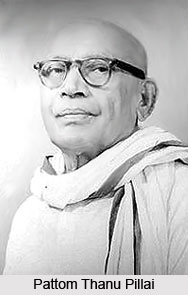 The society of Travancore did witness religion and caste based distinctions. Hindus and Non-Hindus were the two major religious divisions in Travancore. The non Hindus comprised of Christians, Muslims, Jains, Buddhists and Jews. Caste Hindus however had many divisions further. Brahmins, Kshatriyas, Ambalavasis, Nairs and Vellalas were the Hindus. The Ezhavas, Nadars, Kammalas, Fishermen, Pulayas, Parayas, Pallas, Nayadis and the Hill Tribes were the non caste Hindus. The lowest in the high caste ranking was the Nairs and Vellalas. The Nairs had titles like Pillai, Thampi and Menon.
The society of Travancore did witness religion and caste based distinctions. Hindus and Non-Hindus were the two major religious divisions in Travancore. The non Hindus comprised of Christians, Muslims, Jains, Buddhists and Jews. Caste Hindus however had many divisions further. Brahmins, Kshatriyas, Ambalavasis, Nairs and Vellalas were the Hindus. The Ezhavas, Nadars, Kammalas, Fishermen, Pulayas, Parayas, Pallas, Nayadis and the Hill Tribes were the non caste Hindus. The lowest in the high caste ranking was the Nairs and Vellalas. The Nairs had titles like Pillai, Thampi and Menon.
Social Condition of Nair Community
The Pillai title was possessed by those who enjoyed the royal privileges; the Thampi title was given to those who had blood relationship with the king and the Menons came from respectable families. The Nairs in general preferred to serve in the country`s army. The male children were given martial art training between the ages of seven to ten. When the opportunity in the army reduced, they began to fill up the government positions. They were the landlords and Jenmis in Travancore. People of the low caste did ensure that the high castes enjoy all the luxuries. They had followed matrilineal system of legacy. This arrangement was called Marumakkathayam. Sister`s children were the successors as per the rules of this system. Polyandry did prevail amongst the Nairs. The Vellalas of Nanjil Nadu were also called the Nanjil Nadu Nairs. They also had accepted the concept of Marumakkathayam law of inheritance and recognized themselves with the Nairs.
Economic Condition of Nair Community
Feudalism did exist in the erstwhile State of Travancore. During the rule of Tamil kings, Travancore was known as Chera Nadu. The whole state of Travancore was divided into Nadus. Each Nadu was divided into Desams. The man who supervised the Nadu was called Naduvazhi and the Desam, the Desavazhi. The Nairs were assigned the role of Naduvazhis and Desavazhis by the Nambudiris. Jenmis were also a title given to the Nairs. The low castes worked as labourers on the lands of the Nairs. The landlords who sold their lands also sold the low caste people who worked as labourers on those lands, as commodities. The Jenmis system assured the Nambudiris and the Nairs the socio economic and political stability.
Role of Nair Community in Politics
The Nair community wanted to do away with the Dewan system. This was achieved by the Maharaja`s public announcement of responsible government to Travancore. An election was conducted for representative body in the year 1948. The state Congress was headed by Pattom Thanu Pillai who got majority in the Assembly. He had become the Chief Minister. Thereafter Narayana Pillai became the Chief Minister. Cochin State was united with Travancore during his period. This ministry also had a quick exit. The acting constitution which was published on 24 March 1948 made provision for the formation of a ministry under the Chief Minister. The Dewan system was abolished and Maharaja was given all the powers. However he could act only according to the advice of the ministry under the Chief Minister. The Representative Body acted as the Constitutional and Legislative organization. They were authorized to legislate, discuss the financial report, raise questions and pass resolutions. On the same day, the State Congress President Pattom Thanu Pillai became the chief minister. Nair community`s dream to be the controlling power was however fulfilled. The Nairs of South Travancore was the most joyous after this victory. This government did not last long as there were inward fights regarding the policies of the Chief Minister. Above all, the issue of Aykia Keralam posed a very serious problem to the Nair Government. Thanu Pillai opposed as it would disfigure the Travancore state. Prevalence of communal politics also led to this government`s downfall. Thereafter another Nair Chief Minister, Narayana Pillai headed the ministry. He had organized a different party called the Praja Socialist Party in Travancore with important members of State Congress. Travancore and Cochin were united under his leadership. The two State Assemblies were amalgamated into one.
Decline of Nair Dominance
The dominance of the Nair society did diminish during the rule of Marthanda Verma. Marthanda Verma had abolished the feudal system which reduced the power of Nair Jenmies. The system of controlling the armies by the Nair landlords was also stopped. Their lands were confiscated and considered as government lands. Within one year the country which was in anarchy was brought under control and order. This attitude dismantled the Nair domination in Travancore. In the administration too the Nairs were less employed. The reforms in the education department reduced the Nair supremacy.
Nair caste witnessed good and bad phases. Earlier they were the supreme and dominated the lower caste and enjoyed all possible luxuries they could. But as ages advanced people became more educated and policies of different governments gradually reduced the Nair dominance. In present day the scenario has undergone a sea change as the Nairs have opened up by shelving off such caste discriminations.



















